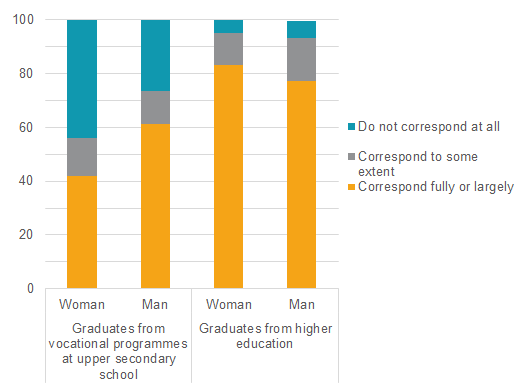Over 9 out of 10 have a job after graduating from higher education
Statistical news from Statistics Sweden 2017-11-27 9.30
Of the graduates from higher education, over 9 out of 10 had work as their main activity in spring 2017, which is three years after graduation. Among the graduates from upper secondary school, more than half of them had work as main activity, while about four out of ten mainly studied.
Graduates from upper secondary school
In spring 2017, three years after graduating from upper secondary school, approximately 80 percent of those who graduated from vocational programmes had work as main activity. More than half of them had a job that fully or largely corresponded to their education, but the proportion was greater among men than among women.
Three years after upper secondary school, 64 percent of those with a degree from a higher education preparatory programme and 10 percent of graduates from vocational programmes have at some point been enrolled in higher education. More than half of all students who have attended higher education think that their upper secondary education has to a great extent prepared them for higher education.
Graduates from higher education
Among those who have graduated from higher education, 80 percent consider their work fully or largely corresponding with the field of their education. The corresponding proportion for those with at least 120 higher education credits but no graduation is 56 percent. The correspondence between work and education is somewhat higher for women than for men.
Those who have studied within the broad fields pedagogy and teacher training or healthcare and social care worked to a greater extent within an area that fully corresponded to their education.
How well the work corresponds with the field of education by sex and type of education
Percent
A larger proportion of women than men attend higher education preparatory programmes in upper secondary school. In addition, regardless of the type of programme, a larger proportion of women than men continue to study at higher education. Among higher education students, a larger proportion of women than men attend three year-programmes. A larger proportion of men attend four year-programmes or longer at higher education, and consider at a higher extent than women do, that second-cycle courses and study programmes or higher is needed for their work.
Definitions and explanations
The survey Entrance to the labor market after upper secondary school was conducted in spring 2017 (April to June). The survey was a combined web and telephone survey and consisted of school leavers from upper secondary school 2013/14, that is, the first pupils passing from the reformed upper secondary school (Gy 2011).
The survey The entrance to the labour market for students in higher education who have completed studies 2013/14 was conducted in spring 2017 (April to June). The survey was a combined post and web survey and consisted of students in higher education who have completed studies 2013/14.
Publication
A more detailed report is available in the theme reports: Entrance to the labor market after upper secondary school and The entrance to the labour market for students in higher education who have completed studies 2013/14.
Feel free to use the facts from this statistical news but remember to state Source: Statistics Sweden.
